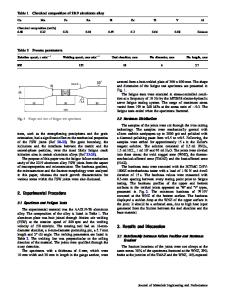Research on Microstructure and Fatigue Properties of Vibration-Assisted 5052 Aluminum Alloy Laser Welded Joints
- PDF / 5,705,955 Bytes
- 9 Pages / 593.972 x 792 pts Page_size
- 79 Downloads / 421 Views
JMEPEG https://doi.org/10.1007/s11665-020-04923-6
Research on Microstructure and Fatigue Properties of Vibration-Assisted 5052 Aluminum Alloy Laser Welded Joints Jiewen Jin, Qinghua Lu, Peilei Zhang, Chonggui Li, and Hua Yan (Submitted October 15, 2019; in revised form May 16, 2020) Vibration-assisted laser welding experiment of 5052 aluminum alloys was carried out to focus on the influences of vibration parameters on microstructure and fatigue fracture. The experiment found that the vibration process homogenized the microstructure and promoted the formation of fine equiaxed grains significantly. In addition, vibration made the hardness uniform by reducing the area of the fusion zone. Experimental results of double welds showed that residual stress reduced by 58 to 77% under the action of micro-vibration. Vibration frequency and vibration acceleration had significant effects on the longitudinal and transverse residual stress, respectively. Under the same fatigue load condition, the average fatigue limits of the base metal (BM) and the welded joints were 160 and 120 MPa, respectively. Under the conditions of 107 cycles, the maximum fatigue strength of the welded joints has reached 74.95% fatigue strength of the BM. Vibration-assisted laser welding could obviously improve the fatigue performance and increase the fatigue life of the welded joints, which was a potential way to improve the quality of welded joints. Keywords
fatigue performance, laser welding, microstructure, micro-vibration, residual stress
1. Introduction 5052 aluminum alloy is an important material for manufacturing cold stamping components, sheet metal products and aircraft parts; it has the advantages of good corrosion resistance, high fatigue limit and excellent weldability. In recent decades, laser welding technology developed rapidly, which has been widely used in the processing and manufacturing field with the outstanding advantages of good processing stability and high processing efficiency (Ref 1, 2). Zhou et al. (Ref 3) investigated the AC A-TIG welding on the 5052 aluminum alloy and studied the effects of various oxides on the performance of welded joints. Among the many welding processes that improved the quality of aluminum alloy welded joints, vibration-assisted welding (VAW) was a potential way to achieve it, which came from the development of vibration aging. Jose et al. (Ref 4) reviewed the new discoveries in the field of VAW and discussed the advantages of the VAW processes, and they also proposed the future research direction, which was vibration of workpiece and welding electrode,
Jiewen Jin, Qinghua Lu, Peilei Zhang, Chonggui Li, and Hua Yan, School of Materials Engineering, Shanghai University of Engineering Science, No. 333 Longteng Rd. Songjiang Campus of Shanghai, Shanghai 201620, China; and Shanghai Collaborative Innovation Center of Laser Advanced Manufacturing Technology, Shanghai, China. Contact e-mails: [email protected], [email protected], [email protected], [email protected], and [email protected].
Journal of Materi
Data Loading...











